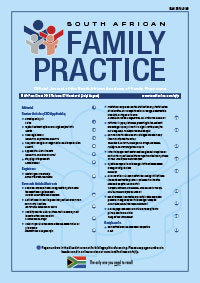Sex differences in correlates of obesity indices and blood pressure among adults in Selangor, Malaysia
Keywords:
BMI, WC, WHR blood pressure
Abstract
Background: Obesity is a risk factor for many chronic diseases and related morbidity and mortality. It is imperative to identify the best index of obesity which has the strongest relationship to blood pressure in various populations. The main aim of this study was to determine the sex differences in correlates of four frequently used obesity indices among Malaysians. Method: A cross-sectional study which recruited 1 530 Malay respondents was conducted in four villages in a district of Selangor state, Malaysia from June until October 2011. Blood pressure and anthropometric indices were recorded using a structured data sheet and data were analysed using SPSS version 17.0. Results: The body mass index cut-off point for the general population shows more overweight than obese respondents for both sexes (male [overweight: 30.7%, obese: 13.8%]), (female [overweight: 32.8%, obese: 21.8%]). The body mass index cutoff point for Asians shows more overweight males compared with obese male respondents (35.8% vs 26.1% respectively) and more obese female compared with overweight female respondents (36.1% vs 32.9% respectively). There were more respondents with abdominal obesity by Asians’ cut-off point for waist circumference across sexes. Almost half of the male respondents have abdominal obesity by waist circumference with both cut-off points. Female respondents according to Asians’ cut-off point have a higher prevalence of abdominal obesity by waist-to-hip ratio compared with women categorised by the general population cut-off point (76.3% vs 55.1% respectively). The majority of the respondents across sexes have a high prevalence of abdominal obesity by waist-to-height ratio. Males had significantly higher mean values for systolic blood pressure, diastolic blood pressure and waist-to-hip ratio compared with female respondents, while females had a significantly higher mean for body mass index and waist-to-height ratio compared with male respondents. There was no significant mean difference for WC between sexes. All indices of obesity were significantly and positively correlated with both systolic blood pressure and diastolic blood pressure. The waist-to-height ratio shows the strongest correlates with systolic blood pressure across sexes (male: r = 0.291 and female: r = 0.294) compared with diastolic blood pressure. Waist circumference correlates most strongly with diastolic blood pressure among male respondents (r = 0.266) and body mass index correlates most strongly with diastolic blood pressure among female respondents (r = 0.250). Conclusion: Waist-to-height ratio performed better than BMI, WC and WHR for its correlates with systolic blood pressure across sexes. Diastolic blood pressure correlates most strongly with waist circumference among male respondents and it correlates most strongly with body mass index among female respondents. The waist-to-height ratio could be a simple and effective tool to screen for high blood pressure among the Malay population. Future research might look into a sex-specific abdominal obesity index for screening of cardiovascular risk factors. (Full text available online at www.medpharm.tandfonline.com/ojfp) S Afr Fam Pract 2015; DOI: 10.1080/20786190.2015.1016719
Published
2015-08-26
Section
Research Articles
By submitting manuscripts to SAFP, authors of original articles are assigning copyright to the South African Academy of Family Physicians. Copyright of review articles are assigned to the Publisher, Medpharm Publications (Pty) Ltd, unless otherwise specified. Authors may use their own work after publication without written permission, provided they acknowledge the original source. Individuals and academic institutions may freely copy and distribute articles published in SAFP for educational and research purposes without obtaining permission.

